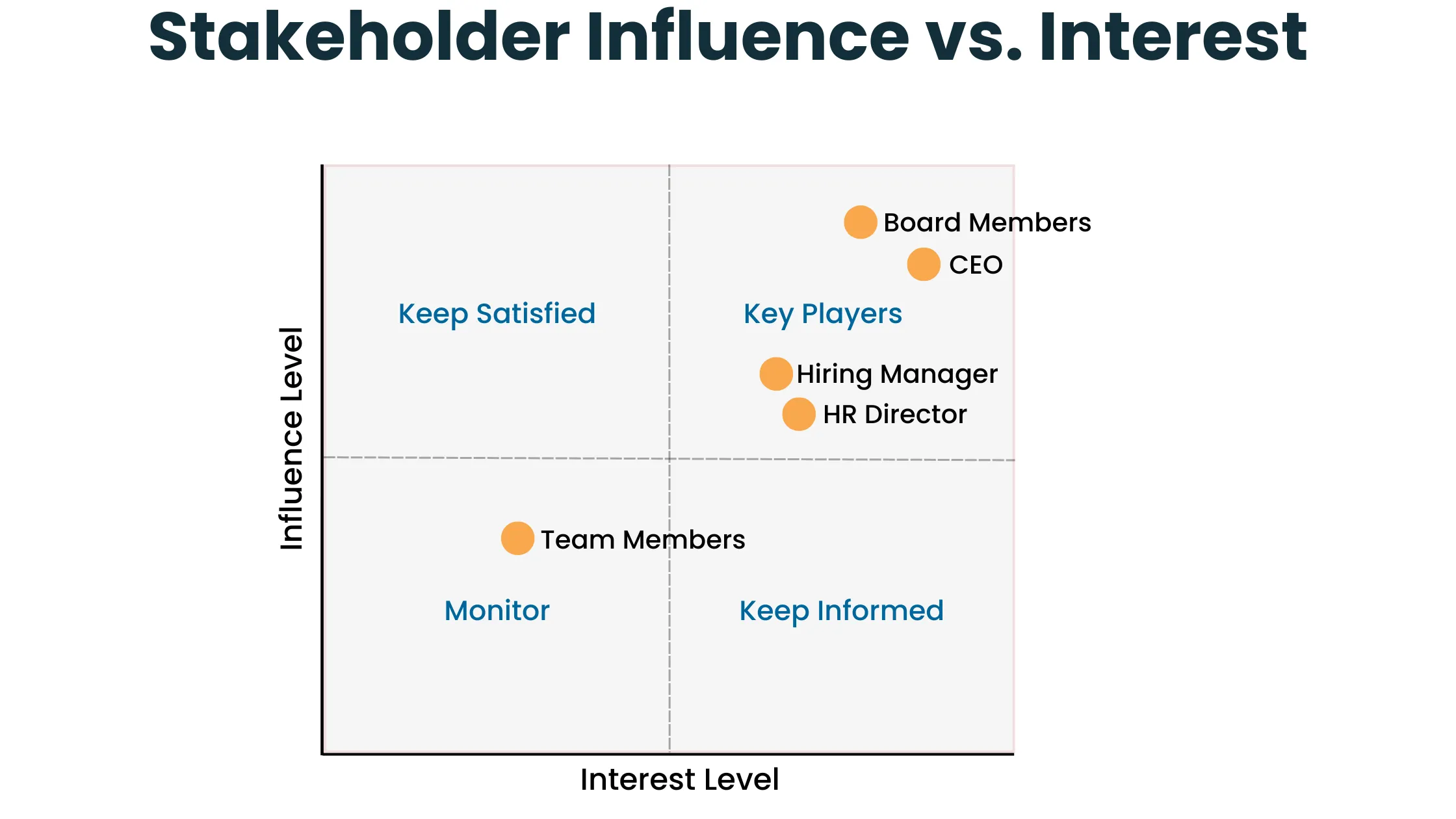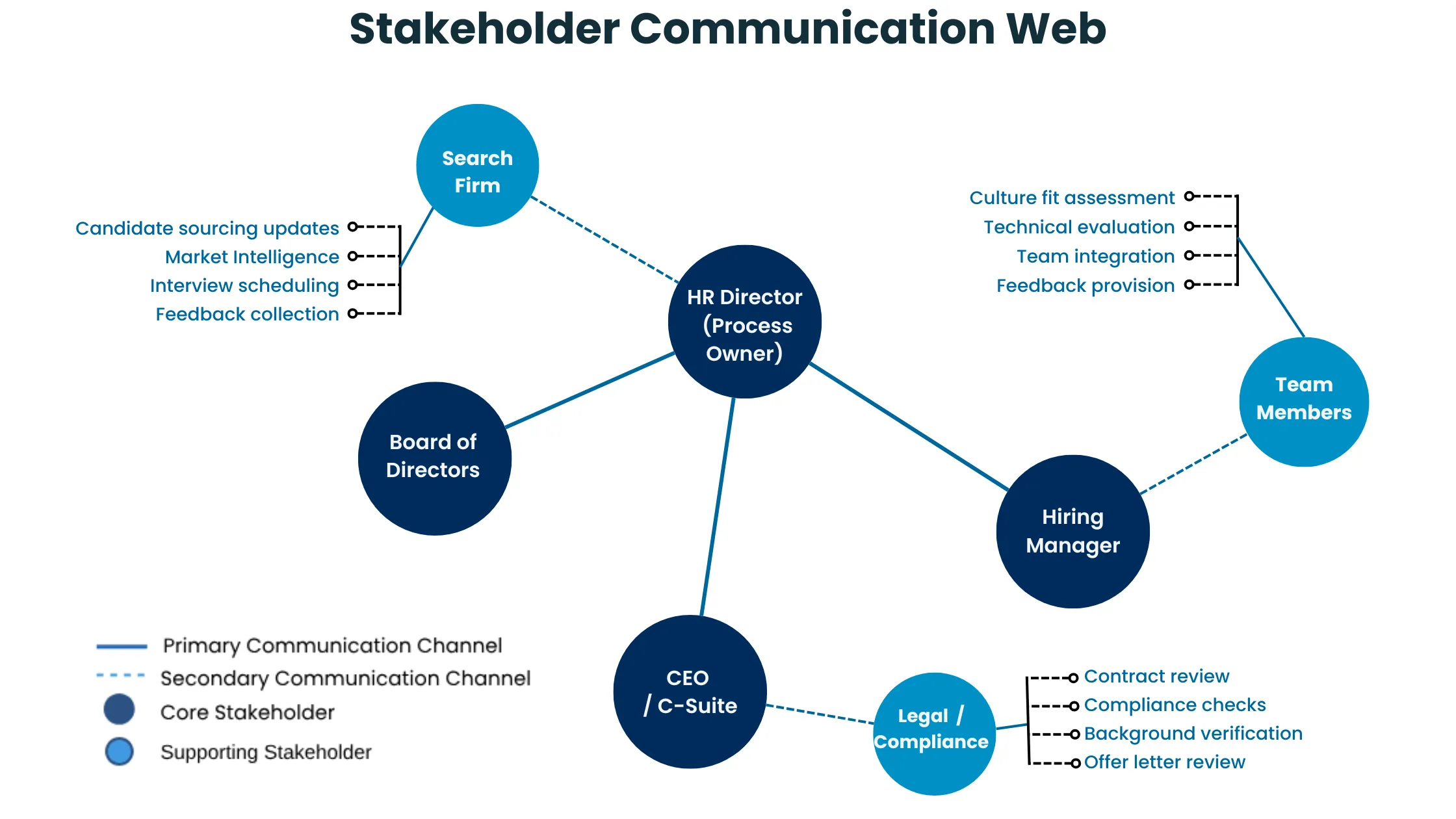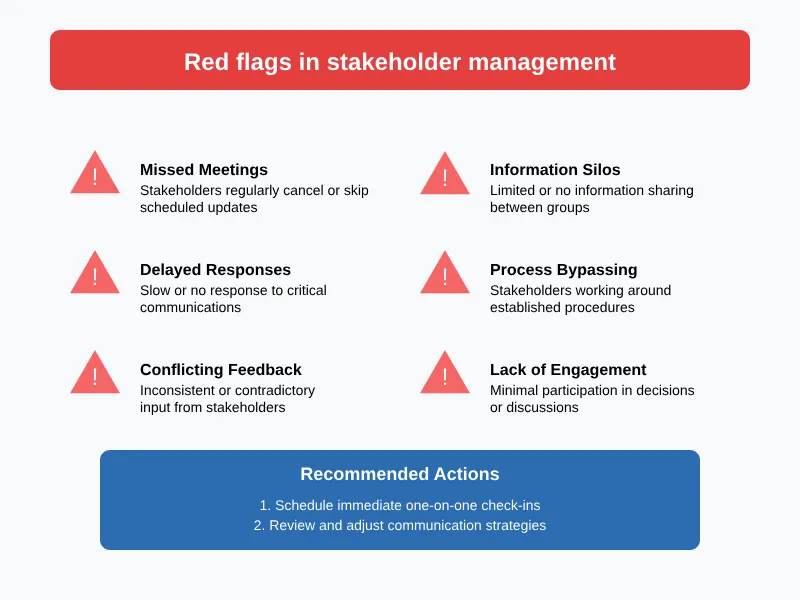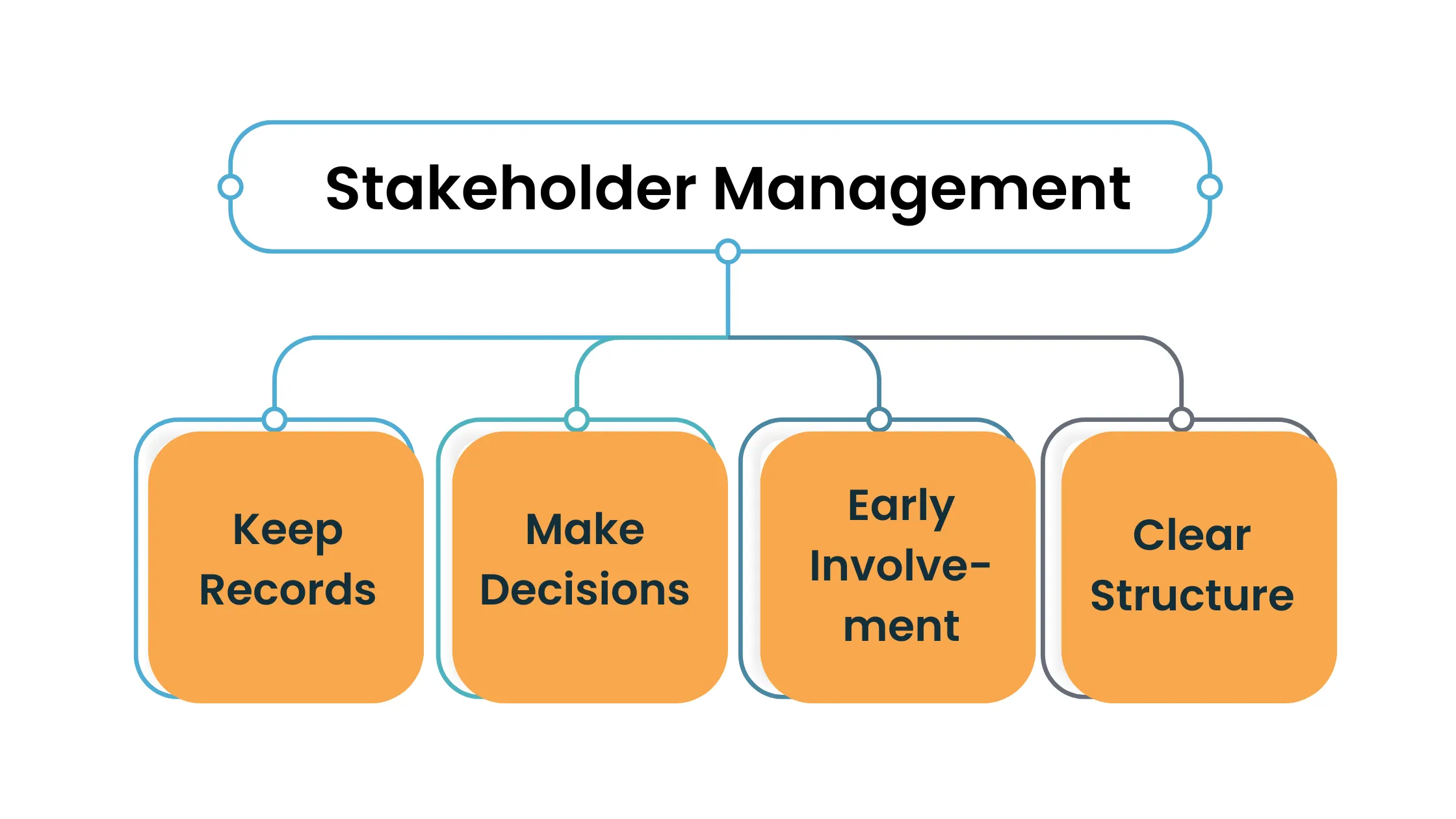TL;DR
- Effective stakeholder management ensures alignment of diverse priorities in executive search.
- Clear communication and expectation setting from the start build a strong foundation.
- Using executive search software enhances collaboration and streamlines processes.
- Managing differing opinions involves objective data and mediation to align goals.
Managing an executive search can feel like trying to meet a dozen different expectations at once. Every stakeholder, whether a board member, C-suite leader, or hiring manager, has their own view of the perfect candidate, and aligning those perspectives isn’t always straightforward. That’s where strong stakeholder management in recruitment becomes essential. When done well, it turns a potentially complicated process into a collaborative one, where everyone works towards the same goal.
With clear communication, well-set expectations, and the right tools, you can bring order to the complexity and ensure the best hiring decisions are made. In this blog, we’ll explore how to manage stakeholders effectively throughout the executive search process while saving time, strengthening relationships, and making each search a strategic success.
Understanding Stakeholders in the Executive Search Process
In executive search, it's like figuring out who the main people are in a big, important game. Each person has their own goals and ideas. Here’s who the main people are and why they are important when looking for top leaders:
Board Members: These are the top decision-makers. They want a leader who matches the company's big plans and values. They look for someone who can help the company grow for a long time and represent the company well.
C-Suite Executives: As peers of the incoming executive, they seek someone who complements the existing team’s strengths, shares core values, and fits seamlessly into the executive culture. They check if the new leader is a good fit both professionally and culturally, which is important for team unity and company spirit.
Hiring Managers: These are the people who work every day in the company. They care about what the new person can do right away and how they will fit in with the team. They check if the executive can lead well and help the department succeed.
Investors: When they are involved, investors want to see growth, good financial results, and stability. They look for someone with a strong history of success who can increase the company's value and bring in more money.
Clients (if important): For jobs that involve working with clients, client opinions matter. They want someone who will keep the relationship strong or make it even better.
Each group has a different role in choosing the right person. By understanding what each group wants, the hiring team can find a candidate who meets everyone's needs - this balance is crucial for long-term success.
Aligning Expectations from the Start
After understanding each stakeholder's specific role and goals, the next step is to make sure everyone's expectations are in sync. This is important to ensure that everyone starts working towards the same goal from the very beginning, which makes the executive search process more efficient.
1. First Meetings with Stakeholders
In the first meetings, you talk to all the important people involved - top leaders, board members, and sometimes even key clients. You discuss the strategic importance of the position, the skills and qualities needed, and any non-negotiable traits. The goal is to get detailed input from each person and understand their vision, priorities, and any concerns they might have. This helps avoid misalignments down the line, ensuring a smoother process later.
2. Setting Success Criteria
Once expectations are aligned, you establish clear, measurable success standards for the position. These standards extend beyond the initial hiring phase to include key milestones expected at different stages - like relationship-building goals within the first 90 days or performance targets for the first year. By setting these benchmarks early, all involved parties have a common understanding of what success looks like, which aids in the selection process and clarifies what makes a successful hire.
By aligning expectations from the start, you create a strong foundation for the entire recruitment process, minimizing the risk of misunderstandings and ensuring everyone is committed to the process.
Creating a Transparent Communication Plan
After aligning expectations, the next step is to create a clear communication plan to keep everyone informed and involved without overwhelming them.
1. Regular Updates
Consistency helps build trust. Set a schedule - like weekly or biweekly updates - where each message focuses on important details that people need to know. Instead of overwhelming stakeholders, highlight the main points, progress in finding candidates, and any changes in strategy. Regular, brief updates keep everyone on the same page and prevent misunderstandings later.
2. Choosing the Right Channels
Different stakeholders have different needs. For quick updates, tools like Slack or project management platforms work well. For more detailed information, emails or shared folders allow stakeholders to review the information at their own pace. Using executive search software to manage all communications in one place is best. Matching the message to the right channel keeps communication efficient so stakeholders stay informed.
Leveraging Executive Search Software for Better Collaboration
Using advanced executive search recruitment software can change how we work with stakeholders during the hiring process. Here’s how it makes things more efficient and helps us build better relationships with top executive talent:
- Two-Way Email Sync: Keeps communication with candidates and clients synced across devices, providing a comprehensive, organised view for the entire team.
- Job Tracker: Manages each assignment’s progress from start to finish, providing stakeholders with a real-time overview of each executive search without constant check-ins.
- AI Candidate Matching: Uses advanced AI to assess and match executives with the unique requirements of high-level roles, filtering out unfit profiles and saving valuable time.
- Interview Management: Schedules, tracks, and coordinates interviews effortlessly, streamlining the process and allowing stakeholders to stay informed on interview progress.
- Score Card: Collects structured feedback from stakeholders on each candidate, ensuring that evaluations are fair, consistent, and focused on executive competencies.
- Executive Profile Generation: Creates detailed profiles highlighting executives’ career achievements, making it simpler to present executives to stakeholders in a clear and visually appealing format.
- Priority Candidate Alerts: Notifies stakeholders when top candidates advance through key stages, allowing quicker decisions and reducing time-to-hire for high-impact roles.
- Collaborative Candidate Feedback Portal: Allows multiple stakeholders, such as board members or senior leadership, to review, comment, and score candidates confidentially within the system, making the feedback process seamless and transparent.
- Client Collaboration Portal: Provides clients with a dedicated portal to track search progress, review candidates, and access documents. It allows high-level clients to stay informed and involved without overwhelming them with details.
This software not only makes finding executives easier but also helps build strategic relationships and manage performance, improving the overall process.
What Are the Key Challenges in Managing Stakeholders During Executive Search?
In executive search, dealing with different stakeholders has its own set of challenges that require skill and strategy.
1. Different Expectations and Priorities
Stakeholders - like board members and hiring managers - often have different priorities, such as fitting into the company culture versus having technical skills. Starting with a clear assignment brief helps create a common ground to refer back to when opinions differ.
2. Handling Internal Politics
When placing executives, it's common to face internal conflicts and different goals. Staying neutral and relying on facts helps keep conversations productive and reduces political issues.
3. Keeping Communication On Track
Keeping everyone informed without overwhelming them can be difficult. A well-organized communication plan with regular updates, supported by executive search tools, helps everyone stay in the loop efficiently.
4. Protecting Candidate Privacy
Finding the right balance between openness and privacy is important. Sharing only necessary professional information while keeping candidate details private builds trust with both sides - a key part of successful executive searches.
Best Practices for Stakeholder Management
Effective stakeholder management in recruitment is very important for a successful executive search. Here are some tips for creating trust, agreement, and a smooth process.
1. Start with Early Involvement: Get stakeholders involved from the beginning to learn about their needs and goals. This early participation helps build trust and ensures everyone is on the same page, avoiding problems later.
2. Set Up a Clear Structure: Define roles and decision-making rules at the start. This structure helps avoid confusion and speeds up approvals, making the process easier.
3. Make Decisions Together: Include different viewpoints by involving everyone in discussions. Regular updates ensure all opinions are considered, helping to agree on the best candidate.
4. Keep Records and Be Transparent: Write down every step, from feedback to decisions, to keep everyone informed. This transparency builds trust and responsibility throughout the process.
5. Risk Management Approaches: Prepare for possible problems and have backup plans. Talking openly about risks helps reassure everyone involved and keeps the hiring process proactive and ready for anything.
Using these methods ensures a clear, organised search that meets the needs of those involved—crucial for a successful executive hire.
Dealing with Different Opinions and Feedback
When working with many people on an executive search, different opinions and feedback are common. It’s normal- everyone has their view on what makes a candidate suitable, especially for top positions.
1. Understanding Different Perspectives
Each person involved - like the CEO who focuses on strategic goals or the CFO who emphasises financial control—has their own criteria for the perfect candidate. The goal is to explore these viewpoints, not just to know what each person values but also why. This helps me find common goals and see where adjustments can be made.
2. Conflict Resolution Technique
When people have different views, you act as a mediator. You use objective information - like performance data, leadership evaluations, and cultural fit scores - to guide the discussion towards measurable factors instead of personal preferences. Then, you show how the candidate meets the most important needs across the board. This helps stakeholders feel understood and aligned, focusing on choosing the candidate who best meets the organisation’s needs.
In the end, dealing with differing opinions isn’t about making everyone happy - it’s about creating understanding and alignment so that the final decision feels right to all.
Building Trust and Authority with Stakeholders
In executive search, building trust and authority is essential for aligning stakeholders and making effective placements.
1. Building Credibility from the Start
Trust starts by showing a deep knowledge of the industry, a clear strategy, and a good understanding of the executive position. From the beginning, displaying this expertise builds confidence, making the search partner a reliable and knowledgeable advisor.
2. Data-Driven Decisions
Data helps make recommendations more credible and clear. Stakeholders appreciate metrics such as performance standards and industry knowledge, which make candidate assessments more objective and evidence-based, leading to better decision-making.
3. Developing Lasting Relationships
Effective executive search goes beyond finding candidates to building long-term partnerships. Regular follow-ups and post-placement reviews show commitment to stakeholders' goals, encouraging repeat business and strengthening trust.
By focusing on credibility, data, and long-term relationships, executive search professionals become trusted advisors crucial to stakeholders' strategic success.
Bottom Line on Stakeholder Management in Executive Search
As you've explored, mastering stakeholder management in executive search is a critical skill that can significantly impact the success of your placements. It's not just about finding the right executives but also about navigating the complex web of interests, expectations, and influences that surround every search process.
By keeping the lines of communication open, tailoring your approach to each stakeholder, and being transparent every step of the way, you're not only managing a search process but also building trust, fostering relationships, and adding real value to your clients' organisations.
So, as you continue to refine your stakeholder management skills, remember that every interaction is an opportunity. An opportunity to understand better, to communicate more effectively, and to demonstrate your commitment to excellence. In the end, it's not just about closing a search but about opening doors to new possibilities and long-term success for all involved.
Keep up the great work, and here's to your continued success in the dynamic and impactful world of executive search! Step into success with our Ultimate Resource for Executive Search.
FAQs - Frequently Asked Questions
1. Who are the key stakeholders in the executive search process?
Key stakeholders include board members, C-suite executives, hiring managers, investors, and sometimes clients. Each group plays a unique role in identifying and selecting the best candidate, making stakeholder alignment essential for a successful hire.
2. Why is stakeholder alignment important in executive recruitment?
Stakeholder alignment ensures everyone is working toward the same goal. It reduces miscommunication, clarifies expectations, and helps avoid delays or disagreements later in the search process. Aligned stakeholders are more likely to support the final hiring decision.
3. What challenges can arise when managing stakeholders during executive search?
Common challenges include conflicting priorities, internal politics, lack of clear communication, and concerns about candidate privacy. These issues can slow down the process or lead to poor hiring decisions if not managed properly.
4. How can executive search software improve stakeholder management?
Executive search software improves communication, tracks candidate progress, automates interview scheduling, and allows for collaborative feedback. These features keep all stakeholders informed and engaged while saving time and reducing manual tasks.
5. What are the best practices for managing stakeholders in executive recruitment?
Best practices include involving stakeholders early, setting clear expectations, keeping communication structured and transparent, resolving conflicts objectively, and building long-term relationships based on trust and results.


















